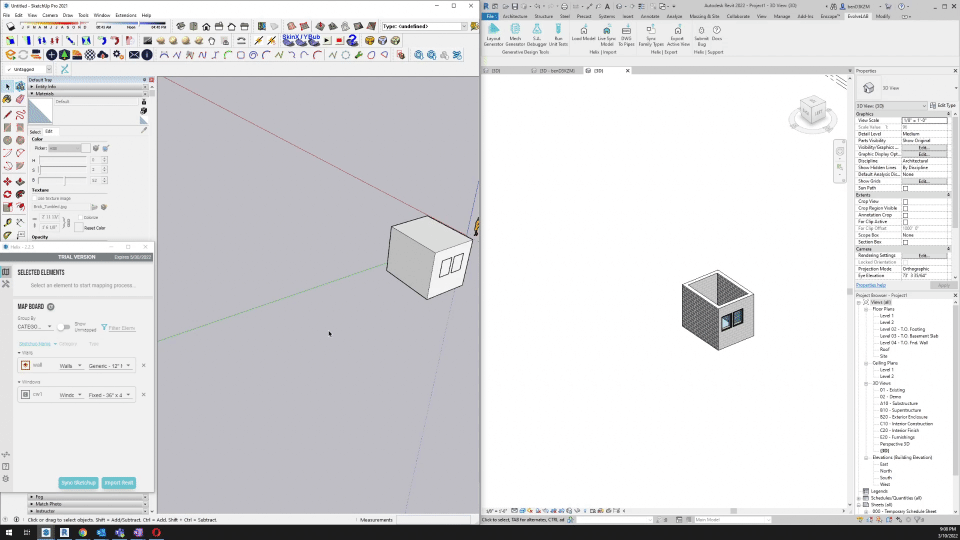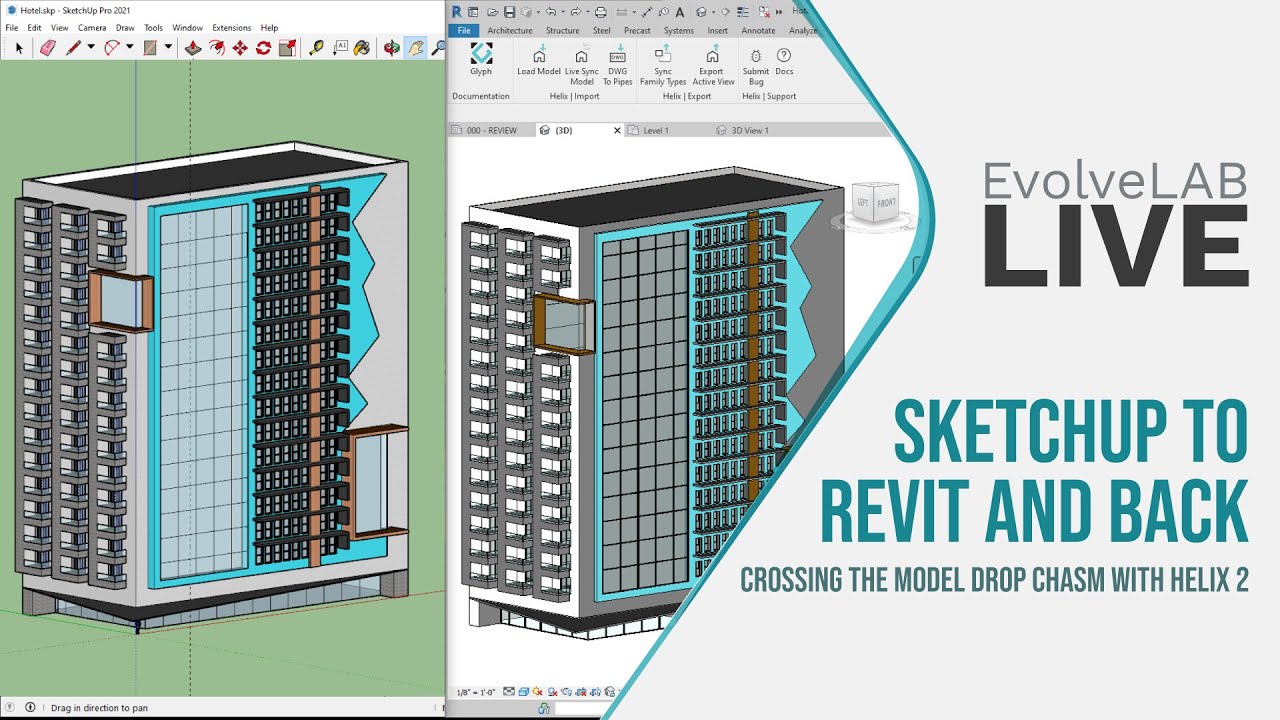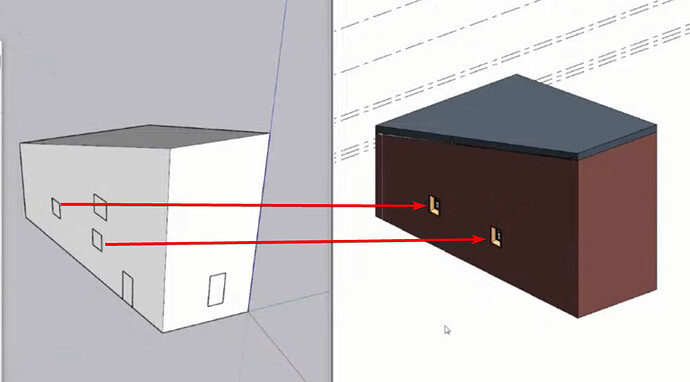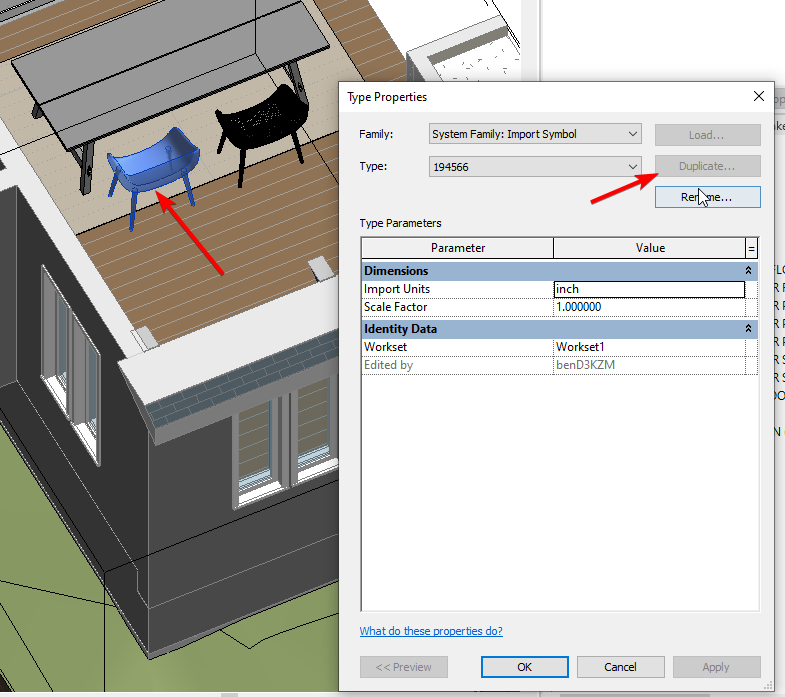We had a great conversation about how Helix can be used for SketchUp and Revit interoperability and many people from the audience contributed with great questions and comments. I wanted to consolidate these comments here as they span across multiple platforms.
BIM MAPPING
Can SketchUp furniture be mapped to Revit families, similar to the way you can with windows and doors?
![]() We currently do not support this, but we’re interested to know if this would be a common way of working with furniture. The DirectShape and the DXF methods allow a 1:1 translation of raw geometry to Revit, as an alternate to mapping to an existing Revit family.
We currently do not support this, but we’re interested to know if this would be a common way of working with furniture. The DirectShape and the DXF methods allow a 1:1 translation of raw geometry to Revit, as an alternate to mapping to an existing Revit family.
Can you put a door in the curtain wall?
![]() We don’t support this workflow yet. We would need to first implement a more advanced curtain wall editor from SketchUp that would align SketchUp mullions to Revit, and would give us access to change the interstitial panels in the system: glazing, spandrel, doors, other…
We don’t support this workflow yet. We would need to first implement a more advanced curtain wall editor from SketchUp that would align SketchUp mullions to Revit, and would give us access to change the interstitial panels in the system: glazing, spandrel, doors, other…
Why is the size of the Revit windows different than the size in the SketchUp window when syncing SketchUp to Revit?
The size of the family is based on the family types that it is mapped to. The SketchUp component provides the insertion point that will align with the Revit family.
![]() We have an feature idea in our backlog that will auto detect the insertion point from SketchUp to use the component’s base center as the insertion, in case the insertion point in SketchUp is not properly maintained.
We have an feature idea in our backlog that will auto detect the insertion point from SketchUp to use the component’s base center as the insertion, in case the insertion point in SketchUp is not properly maintained.
![]() We also have another idea in our backlog that can auto detect the height and width of a window (or other BIM elements) in SketchUp, and map those sizes to the mapped family parameters for width and height. We are thinking of first supporting instance parameters, as type parameters would require the mapping to also include a new type generator, rounding and naming criteria for those new types.
We also have another idea in our backlog that can auto detect the height and width of a window (or other BIM elements) in SketchUp, and map those sizes to the mapped family parameters for width and height. We are thinking of first supporting instance parameters, as type parameters would require the mapping to also include a new type generator, rounding and naming criteria for those new types.
![]() A third feature idea for this workflow is hybridizing the window geometry with the mesh based workflows. For example, let’s say that you have an window with very ornate geometry that you would like to get into Revit using the exact geometric representation from SketchUp. We can extract that mesh based geometry, detect the cutting geometry outline and create a native window in Revit that will cut walls correctly, but will have a fixed height and width as the mesh geometry is used within that family.
A third feature idea for this workflow is hybridizing the window geometry with the mesh based workflows. For example, let’s say that you have an window with very ornate geometry that you would like to get into Revit using the exact geometric representation from SketchUp. We can extract that mesh based geometry, detect the cutting geometry outline and create a native window in Revit that will cut walls correctly, but will have a fixed height and width as the mesh geometry is used within that family.
![]() We be curious to know which of these feature ideas are important to your workflows: reply below to let us know.
We be curious to know which of these feature ideas are important to your workflows: reply below to let us know.
Can the window mapping be switched to curtainwall mapping instead?
![]() Yes. We can do that, and the curtain wall family gets placed in Revit. However, the curtain wall placement in relation to the wall placement is not ideal, as it does not automatically cut the wall. Manually moving the curtain wall instances into the wall does resolve the issue, and will give the desired outcome of using curtain walls instead of windows.
Yes. We can do that, and the curtain wall family gets placed in Revit. However, the curtain wall placement in relation to the wall placement is not ideal, as it does not automatically cut the wall. Manually moving the curtain wall instances into the wall does resolve the issue, and will give the desired outcome of using curtain walls instead of windows.
![]() We could introduce a setting that would offset the wall location of curtain walls from the surface. Or we could model them separately offset in SketchUp to force the curtain wall to be set into the wall. This would also differ for different “parent” walls and different mullion width types. Perhaps those parameter values could be read to have a calculated offset from finish face of both elements…
We could introduce a setting that would offset the wall location of curtain walls from the surface. Or we could model them separately offset in SketchUp to force the curtain wall to be set into the wall. This would also differ for different “parent” walls and different mullion width types. Perhaps those parameter values could be read to have a calculated offset from finish face of both elements…
What Revit categories does Helix support when translating from SketchUp to BIM?
For native Revit content we currently support: wall, roof, floor, ceiling, door, window, curtain wall, topography, pipes and levels. For mesh data using Direct Shape, users can specify any Revit category from SketchUp. For mesh data using DXF, they come in as an Import Symbol in Revit. For a complete breakdown, see this post: SketchUp ⥤ Revit | Supported Categories and Mapping
There are two ways to map surface based components: by layer and by material. Why would you use one over the other?
We made a separate post with the pros and cons of using one way versus the other: Helix BIM Workflow: Map by Materials OR Map by Layer (Tag)?
Do levels have to be determined in Revit first? Or is there support for SketchUp to Revit workflow?
![]() We have a “Add Level” button in SketchUp that will send the SketchUp Levels to Revit.
We have a “Add Level” button in SketchUp that will send the SketchUp Levels to Revit.
![]() We’re also working on a feature that will send all the levels from Revit to SketchUp.
We’re also working on a feature that will send all the levels from Revit to SketchUp.
![]() Currently the level bounds and rotation are not synchronized, but this would be interesting to add as a feature.
Currently the level bounds and rotation are not synchronized, but this would be interesting to add as a feature.
![]() Another feature modification we’re working on, is to only update a level instead of deleting and recreating, when there is an elevation change in SketchUp.
Another feature modification we’re working on, is to only update a level instead of deleting and recreating, when there is an elevation change in SketchUp.
MECHANICAL, PLUMBING, ELECTRICAL, STRUCTURAL SUPPORT
Like levels support, will column grids be supported?
![]() Implementing support for column grids becomes very important when we start to include structural elements support: columns, beams, bracing. As we start to support these elements, we will have to include this feature within that effort.
Implementing support for column grids becomes very important when we start to include structural elements support: columns, beams, bracing. As we start to support these elements, we will have to include this feature within that effort.
Will structural elements work similar to the mapping of the architectural elements?
![]() The UI will be similar, but for many elements the base geometry will be a line. Placing those lines on the correct tag (layer) would set them to the correct element in Revit. These features would closely resemble the SketchUp pipes to Revit (we didn’t have time to demo this in the presentation). We’ll cover the non-architectural workflows in a future talk.
The UI will be similar, but for many elements the base geometry will be a line. Placing those lines on the correct tag (layer) would set them to the correct element in Revit. These features would closely resemble the SketchUp pipes to Revit (we didn’t have time to demo this in the presentation). We’ll cover the non-architectural workflows in a future talk.
MATERIALS
Do SketchUp materials translate to Revit Materials?
![]() When mapping to BIM elements from SketchUp to Revit the Revit library materials that are standardized with that element will be used. This mapping can be made per the SketchUp material or per the SketchUp tag (layer)
When mapping to BIM elements from SketchUp to Revit the Revit library materials that are standardized with that element will be used. This mapping can be made per the SketchUp material or per the SketchUp tag (layer)
![]() When mapping using mesh based methods (DirectShape or DXF) the materials from SketchUp are not converted to Revit materials. However, a user can manually set a Revit material to these objects.
When mapping using mesh based methods (DirectShape or DXF) the materials from SketchUp are not converted to Revit materials. However, a user can manually set a Revit material to these objects.
![]() We would be curious to know how important it is for users to have the ability to convert SketchUp materials with textures to Revit materials: let us know in a reply below.
We would be curious to know how important it is for users to have the ability to convert SketchUp materials with textures to Revit materials: let us know in a reply below.
Can the materials come through, or are we able to see layers of the import symbol to add material to the parts and pieces?
![]() Yes, the material can manually be set in the import symbol subcategory. However, at the moment the entire DXF object is one material. The current workaround is to break the element into separate pieces by material, and map those separately as DXFs.
Yes, the material can manually be set in the import symbol subcategory. However, at the moment the entire DXF object is one material. The current workaround is to break the element into separate pieces by material, and map those separately as DXFs.
![]() We could add a feature to separate the meshes into each respective material that originated from SketchUp and name the subcategory with the SketchUp material name.
We could add a feature to separate the meshes into each respective material that originated from SketchUp and name the subcategory with the SketchUp material name.
![]() Another relevant feature we’ve discussed internally is to include a material editor for the DXF imported elements within Revit, to easily control setting the DXF materials. This way users don’t have to open up the import symbol object styles window in Revit.
Another relevant feature we’ve discussed internally is to include a material editor for the DXF imported elements within Revit, to easily control setting the DXF materials. This way users don’t have to open up the import symbol object styles window in Revit.
It would be cool to have PBR materials from SketchUp.
![]() This would be cool. If we had the SketchUp to Revit material conversion, we could extend it beyond just converting the textures and setting them to the correct geometry. We could also add a mapping to a material appearance asset template for the common Revit material types.
This would be cool. If we had the SketchUp to Revit material conversion, we could extend it beyond just converting the textures and setting them to the correct geometry. We could also add a mapping to a material appearance asset template for the common Revit material types.
![]() An alternate to this would be to map existing SketchUp materials to existing Revit materials for the mesh based elements.
An alternate to this would be to map existing SketchUp materials to existing Revit materials for the mesh based elements.
MESH TRANSLATION
Are LOD for meshes implemented?
![]() This is really cool idea! For mesh based workflows, we could poly reduce the mesh and store it in different LODs, highest being the original, and lower from there. We don’t currently do this, as we do not wrap the imported mesh geometry into a family yet.
This is really cool idea! For mesh based workflows, we could poly reduce the mesh and store it in different LODs, highest being the original, and lower from there. We don’t currently do this, as we do not wrap the imported mesh geometry into a family yet.
Can you duplicate and rename the chairs?
![]() The “Import Symbols” or DirectShapes cannot be duplicated in Revit.
The “Import Symbols” or DirectShapes cannot be duplicated in Revit.
![]() Currently, you can import these geometries by having a new family document active. Then load that family into your project.
Currently, you can import these geometries by having a new family document active. Then load that family into your project.
![]() However, if would be cool to automatically wrap these elements into a family first and load them into the running project.
However, if would be cool to automatically wrap these elements into a family first and load them into the running project.
Can you explain how a furniture schedule would be created from the imports?
The DirectShape based imports can be mapped to the furniture category, and they will show up on furniture schedule like other families would.
The DXF imports would need to be imported into a furniture family first, then load the family into the Revit project.
![]() We do have a feature idea to automate the family wrapper work for DXF imports.
We do have a feature idea to automate the family wrapper work for DXF imports.
Are organic shapes from SketchUp to Revit supported?
![]() Yes! Since everything in SketchUp is mesh based, you can transfer the geometry using the DXF mesh based translator to get the geometry 1:1 into Revit. However, this is not the same as a smooth surface that something like Rhino would import and could be used for wall by face within Revit. This workflow works for objects that do not need to be modified further in Revit.
Yes! Since everything in SketchUp is mesh based, you can transfer the geometry using the DXF mesh based translator to get the geometry 1:1 into Revit. However, this is not the same as a smooth surface that something like Rhino would import and could be used for wall by face within Revit. This workflow works for objects that do not need to be modified further in Revit.

HELIX CONCEPTS AND VISION
What if there is a design change later in the project, is the link maintained?
![]() The Helix data is persistent across sessions and saved into the Revit model.
The Helix data is persistent across sessions and saved into the Revit model.
![]() However, if the standards for SketchUp to Revit models changes across projects, then the mapping would have to be manually updated for the different projects whenever switching projects. A simple solution for this is to add the ability to export and import mappings to work for the particular projects.
However, if the standards for SketchUp to Revit models changes across projects, then the mapping would have to be manually updated for the different projects whenever switching projects. A simple solution for this is to add the ability to export and import mappings to work for the particular projects.
![]() Another more elaborate feature is to introduce the concept of projects within coupled models. This ideas is really cool as it opens the door for multiple SketchUp users to sync to a single Revit model across SketchUp versions and across the office.
Another more elaborate feature is to introduce the concept of projects within coupled models. This ideas is really cool as it opens the door for multiple SketchUp users to sync to a single Revit model across SketchUp versions and across the office.
How do model updates work from SketchUp to Revit?
Only elements that changed in SketchUp will update in Revit when syncing the models. At the moment, the update technique erases the changed model and create a new one in its’ place. This operation does result in a new Revit element id, and any annotations or other elements hosted to that changed element will get deleted.
![]() This is a quick implementation from the coding standpoint that recycles the creation methods. However, we are looking at how we would implement an updater that will preserve the element id’s, and only update the changed parameters or geometry location, instead of recreating it.
This is a quick implementation from the coding standpoint that recycles the creation methods. However, we are looking at how we would implement an updater that will preserve the element id’s, and only update the changed parameters or geometry location, instead of recreating it.
Does the EvolveLAB Team see this as a tool to maintain the models on both platforms? Or as a translation as it moves to CD?
We see SketchUp and Revit as tools that are the BEST for certain workflows, and we want to reduce the friction between using both platforms synergistically throughout the project design and construction process. For example, if there is an interior designer that will primarily work in SketchUp with an architect that works in Revit, then both should be able to use the tools that empower them without having to worry how they all come together. The interior designer could load the Revit model background for their work, and the architect can load back the interior designers work for reference.

THANK YOU
Thank you for making time to take part of our conversation. The conversation has just begun, so feel free to join in if you haven’t. Looking forward to future conversations on the forums and other platforms.



